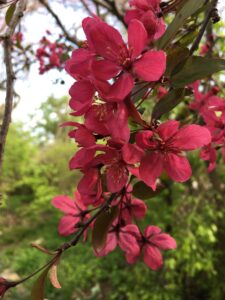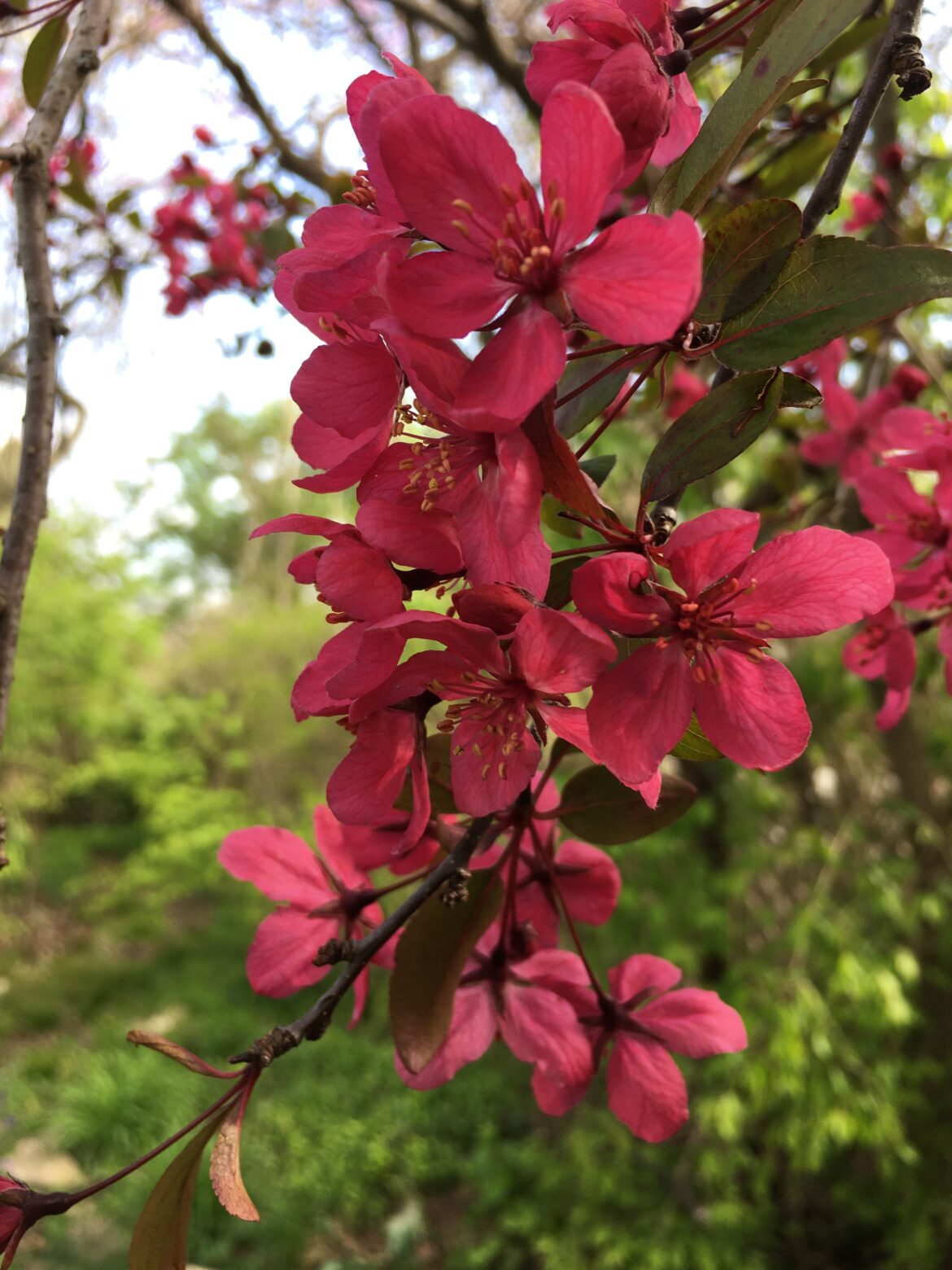April 24th
 The 114th Day of the Year
The 114th Day of the Year
Salve ver optatum,
amantibus gratum,
gaudiorum
fax multorum….
Hail, long desired spring,
boon to lovers,
shining torch of many joys….
MSS Benedictbeuern (bf)
Sunrise/set: 5:45/7:22
Day’s Length: 13 hours 37 minutes
Average High/Low: 65/44
Average Temperature: 54
Record High: 88 – 1925
Record Low: 25 – 1910
Weather
Fine weather is the rule for April 24th: ten percent chance of a high in the 80s, fifteen percent of 70s, fifty-five percent of 60s, twenty percent of 50s. The sun shines 75 percent of the days, and rain comes just twice in a decade on this date. Frost occurs only once in a decade.
Natural Calendar
Azaleas blossom throughout the Lower Midwest in the warmest Aprils, just as field grasses and winter wheat become long enough to ripple in the wind. Chickweed has filled in the woodland floor. Silver and red maple seeds are an inch long. Flowering pears are passing their best, starting to get their leaves. Ferns are at least six inches tall in the new shade. The first yellow celandine blossoms in the alleys. Yellow-bellied sapsuckers mate as buckeyes come into bloom. Admiral butterflies hatch.
Daybook
1982: Winter cress and ragwort bloom begins, and Solomon’s plume is ready. Wild strawberries flowering, hepatica done for the year, its new leaves coming out.
1984: Speckled bird egg found broken on the ground.
1986: Cherry blossoms mostly gone by today, a ten-day cycle of bloom in this warm April. Buckeye flowers are completely open now, dogwood in full bloom,
1988: Yellow-bellied sapsuckers seen mating beyond Sycamore Hole. Angelica coming up on the way to Middle Prairie. Most of the forsythia is gone at home. No more daffodils.
1989: Sparrows still building nests under the eaves. Yellow-bellied sapsuckers mating beyond my second fishing hole in the river.
1991: The box elder canopy is filling in, and from Clifton Road; the creek valley is touched with rounded pale green domes. At Aullwood, garlic mustard, winter cress, shepherd’s purse, bluebells, large-flowered celandine in full bloom. In Yellow Springs the pears are leafing, cherry and buckeye trees full late bloom. Some maple flowers falling. First iris opens in front of the house, tulips full bloom, even the late daffodils slightly past their prime, lilacs coming in.
1993: Very first blossom on the pie cherry tree today. Buds have formed on peonies and red raspberries.
1995: In the cool afternoon, pear petals are falling throughout town as the apple and cherry blossoms are at their best. Silver maples start to leaf. Lil’s sugar maple and ours in bloom. Ash buds are greening. First garlic mustard opened today. Celandine early full bloom now.
1998: Full celandine and purple speedwell. Some of the first apple petal fall. First clematis opens in the garden. End first wave of early dandelions. Last days of the fritillaria. Red and white bleeding hearts are in the center of their season. First wood hyacinth opens by the cherry tree stump. Lilacs on the downside of their blossoming, but still prominent. Garden asparagus has become too mature to eat.
1999: Madison to Yellow Springs, returning to late Middle Spring. Halfway between Rockford and Bloomington, the trees along are river are either in bloom or leafing. Twenty miles north of Bloomington, full dandelion flower. By Danville, grass is long enough to ripple in the wind. Redbuds and crabs in full bloom on the bright green hillsides. Spring beauties in Crawfordsville.
2000: Azaleas open in the east garden, and one star of Bethlehem unravels. One fritillaria left.
2001: Fleabane blooming in the protected microclimate at the south edge of house. Wheat is 12 to 18 inches on the road to Chillicothe, almost waving in the wind. Petalfall starts as Bradford pears collapse. Late tulips hold. Ferns to two feet. In the pond, loosestrife is two feet as well.
2002: First wisteria blossom today, first celandine flower, first star of Bethlehem. Beech just starting to leaf. Daisies budding. Wheat a foot tall.
2003: Some red oak leaves at Mills Lawn park are almost two inches long, other reds only a half an inch. First garlic mustard flowers opened today along the front sidewalk, and the first pink quince flower has unraveled.
2005: Beech leaf sheaths are extended, sharp, but not unraveling.
2006: Inventory: Full dead nettle, buds on wood hyacinth. Pink quince, apples, lilacs, redbuds, apple cherries, celandine, garlic mustard, dandelions, violets all full. Sage well leafed. Parsley big enough to pick. Bamboo three feet. Leafing rose of Sharon, monarda six to eight inches, earliest cress to seed. Three-fourth inch buds on the peonies, astilbe and waterleaf fully leafed, hosta half size, honeysuckles and mock orange budded. Late bluebells. Lungwort still pink, oakleaf hydrangea leaves two inches, daisies budded, ferns to three feet, purple deadnettle aging, daylilies fully developed foliage, small viburnum in the north garden done blooming, but other viburnums are still full in town.
White mulberry has one-inch leaves, side-flower hydrangea has three inch leaves, Asiatic lilies to two feet, heliopsis bushy, Canada thistle to two feet, mid-season tulips rapidly collapsing, still white daffodils, the first few star of Bethlehem and sweet rocket, Dutch iris two feet, lily of the valley has bells, white boneset to one foot, mint strong, first cressleaf groundsel opening, catmint bushy, rhubarb lush, first strawberry flower, catchweed tall and sticky, Queen Anne’s lace a foot tall, bleeding hearts full, new apple tree full deep pink, Japanese knotweed to six feet, full pale azalea, first red azalea, first east garden late tulips, Virginia creeper fresh red shiny leaves, full forsythia leafed (all yellow gone), full honeysuckle leaf barrier, clematis tangled budded and leafing, wisteria leaf stems to three inches, Korean lilac keeps its tight buds, pears fully leafed in town, box elder leaves maybe half size, blue speedwell tall and full, red quince leafing, flowers holding. No locust or Osage flowers or leaves yet. At the park, the small-flowered mock orange is opening.
2007: Red quince still in bloom. Dandelion peak throughout Dayton and the countryside, a little late. More dogwoods opening. Some lily of the valley tight and five inches; other patches have fully developed foliage. Lil’s maple well leafed. The first azalea flowers are coming out in the east garden. Thyme-leafed speedwell noticed blooming as I cut the grass this afternoon.
2008: Another soft morning. The first lilac bud and the first azalea bud opened overnight. The early white, pale yellow, and the orange tulips are almost gone, scilla almost disappeared, daffodils further decayed. Leaves are coloring the forsythia, the serviceberries and the pears. Heavy petalfall on most of the large star and the pink magnolias, but Don’s pink magnolia is just reaching its best. Red quince still full, dandelions still at their peak. John called from Lanesboro, Minnesota: the grass is just starting to green up, he said, and crocus were the only flowers in sight. Other bulbs were about three or four inches tall. Here in Yellow Springs, Ruth Paige called to say she saw the first hummingbird at her viburnum today. The earliest in the Dayton Audubon Society book of birds lists April 20, 1964 as the earliest date observed for hummingbird arrival and May 5th the average date.
2009: The bee swarm is still in the hackberry tree early this morning as the temperature rises toward 80. The serviceberry flowers have shriveled, replaced by gray-green leave. At Moya’s and at Don Beard’s, the pointed-petal yellow tulips are in full bloom. At home, the first chives have budded. Celandine buds are getting ready to open. The fritillaria blossomed overnight. Chickweed is full under the Korean lilac. Standard lilacs, violet and white, are open. The cats were batting at the first wasps this morning at the east window. Pond cleaned this afternoon, one of the two-year-old dark fish seen. The bees left late in the morning. The mother cardinal is still on her nest in the bamboo.
2011: First garlic mustard open in the yard.
2012: No birds at 4:40, faint robins at 4:50, strong robin calls at 5:00, cardinal heard at 5:15, crows, grackles and doves by 6:00. The iris on Stafford Street are in full bloom, and the buckeye trees there are fully budded. Don’s serviceberry trees have green berries, and Mateo’s black walnut tree is leafing out now, ahead of the trees of heaven, which were burned back by frost weeks ago. Dogwoods are in decline.
To the Koogler Reserve of the Beavercreek Wetlands this afternoon: Inventory of plants – only a few in bloom: blackberry, hemlock, fleabane, winter cress, common ragwort, agrimony, swamp buttercup, small-flowered buttercup, multiflora roses, purple violets, garlic mustard, jumpseed, honeysuckles, ironweed, sycamore, box elder, buckeye, small sedum, panicled dogwood, touch-me-nots, maples, corn salad, angelica, horse tail (glades full of it), spring cress, one magnificent cowslip, “May buttercup,” golden Alexander, ground ivy, thin-leafed waterleaf, lilies, asters, dock (some in full bloom), Canadian thistles, a few wonderful patches of forget-me-nots, germander, hops, cattails, water willows, teasel and a number of current shrubs with yellowish flowers, certainly a Ribes, and likely the wild black current, Ribes americium. A beautiful habitat, contained, easy to walk, with many dramatic vistas and wonderful tall trees. Ruby called this morning, still had not seen any hummingbirds, even though she said she had put her feeder out in March.
2014: In Dayton, sycamores are starting to leaf. When I got home, I found a message from Ed Oxley: He had seen the first tiger swallowtail – just a few days later than the earliest sightings I’ve noted here. (But they were flying during many of our Early Spring trips south, the earliest tiger seen near the Georgia border on February 28 of 2012.) In the alley at home, the bittersweet is showing leaves.
2016: North to Delaware, Ohio today, cool and sun: We drove north back into the full bloom of dandelions and crabapples. At home, I found that the deer had eaten the tops off of the phlox. But lily-of-the-valley plants had their first flowers.
2017: Spain: To Muxia on the sea: Once more clear skies, but now with a little fog. We walked through hamlets and eucalyptus forests, up and down hills, now the most prominent wildflower being purple columbine. Many nasturtiums blooming in front of homes, and one field of golden swamp iris, ferns throughout, half emerged, one small patch of birds foot trefoil, two new yellow flowers with five petals about an inch across, tucked into the ground covers, reluctant to show their leaves to me. So as I walked, variety seemed to thin, and the beach habitat here, like others I have seen, less varied. Most butterflies, though, of all the walk through Galicia.
2019: Pears starting to shed, petals building up in the gutters. American toads still singing at Ellis. The first lily of the valley buds have appeared along Elm Street. In the alley between Stafford and Phillips Streets, the first garlic mustard plants have opened.
2020: The crabapples at the Bill Duncan Park are peaking, and my red crabapple is just reaching early bloom. Moya’s yellow tulips with pointed tips, remnants of Mrs. Lawson’s yard half a century ago, have passed their prime.
There’s an art of attending to weather, to the route you take, to the landmarks along the way, to how if you turn around you can see how different the journey back looks from the journey out, to reading the sun and moon and stars to orient yourself, to the direction of running water, to the thousand things that make the wild a text that can be read by the literate.
Rebecca Solnit


